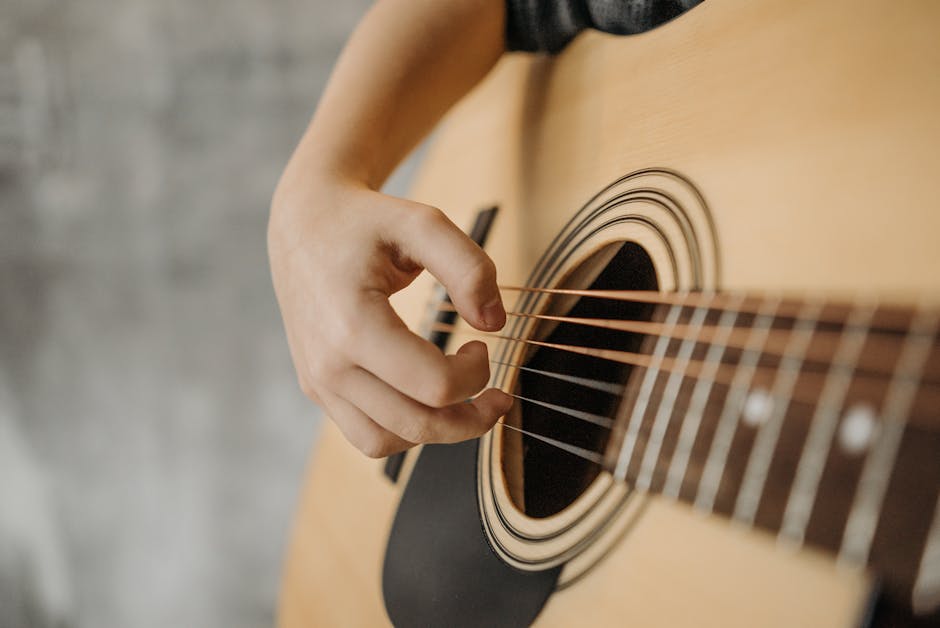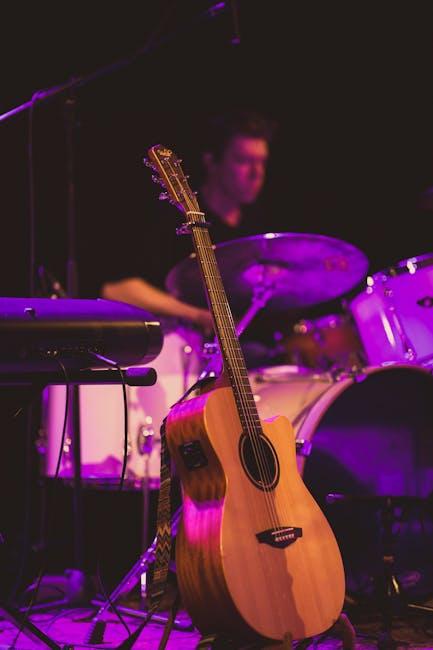Are you tired of strumming the same old basic chords on your guitar? Ready to take your skills to the next level and impress your friends with some seriously complex chord progressions? Well, you’ve come to the right place, my friend. Buckle up, because we’re about to dive into the wild world of mastering complex chords and elevate your guitar skills to rockstar status. Whether you’re a beginner looking to spice up your playing or a seasoned pro wanting to push your boundaries, get ready to unleash your inner guitar god and blow some minds with your newfound chord mastery. Let’s do this! Chords“>
Chords“>
Contents
- 1 Understanding the Foundation of Complex Chords
- 2 Exploring Extended Chords and Their Construction
- 3 Mastering Chord Inversions for a Fuller Sound
- 4 Incorporating Diminished and Augmented Chords into Your Play
- 5 Advanced Techniques: Tapping and Fingerstyle for Chord Complexity
- 6 Navigating Through Modal Interchanges and Chord Substitutions
- 7 Expanding Your Repertoire with Jazz Chords and Progressions
- 8 FAQs
- 9 Rock on, Guitar Maestro!
Understanding the Foundation of Complex Chords
So you want to dive into the world of complex chords, huh? Well buckle up, because things are about to get wild!
First things first, let’s talk about the good ol’ major and minor chords. You know, the ones that make you feel all warm and fuzzy inside. But wait, there’s more! Complex chords take things up a notch by adding extra notes on top of these basic building blocks. Think of it like adding sprinkles to your ice cream – it’s the same delicious treat, just with a little extra pizzazz.
Now, let’s talk about the nitty gritty of complex chords. They’re made up of intervals, which are basically the spaces between notes. These intervals determine the flavor of the chord – whether it’s sweet and harmonious or spicy and dissonant. So when you’re playing that funky chord progression, just remember that it’s all about finding that perfect balance of intervals.
And finally, let’s not forget about the importance of tension and resolution in complex chords. Tension is like the cliffhanger in your favorite TV show – it keeps you on the edge of your seat, waiting for that sweet resolution. So when you’re playing those juicy, complex chords, remember to embrace the tension and savor the satisfying resolution that comes after.
Exploring Extended Chords and Their Construction
Extended chords are like the extra toppings on your musical pizza – they take your basic chord and add some pizzazz! These chords are constructed by adding additional notes beyond the basic triad, creating a richer and more complex sound. So buckle up, because we’re about to dive into the wild world of extended chords!
When constructing extended chords, one common method is to stack thirds on top of each other. This means starting with the root note of the chord and then adding notes that are a third interval apart. For example, if you have a C major chord (C-E-G), you can add a major third (B) on top to create a Cmaj7 chord (C-E-G-B). It’s like adding sprinkles on top of your ice cream – it just makes everything better!
But wait, there’s more! Extended chords can go even further with added notes like ninths, elevenths, and thirteenths. These chords can add a whole new dimension to your music, giving it depth and complexity. And hey, who doesn’t want to sound like a musical genius with all these fancy chords in their arsenal?
So next time you’re jamming out on your guitar or tickling the ivories on the piano, don’t be afraid to throw in some extended chords. They might just be the secret ingredient that takes your music from bland to grand! Keep experimenting, keep exploring, and keep making those chords sing!
 Mastering Chord Inversions for a Fuller Sound”>
Mastering Chord Inversions for a Fuller Sound”>
Mastering Chord Inversions for a Fuller Sound
So you’ve mastered your basic chord shapes, but you’re yearning for something more than just your typical sound. Enter: chord inversions. These bad boys take your regular, run-of-the-mill triads and mix them up in a way that will make your music sound fuller and more complex.
Think of inversions as the fancy spice rack of chords. Sure, salt and pepper get the job done, but why not throw in some paprika and cumin for a little extra pizzazz? That’s what inversions do for your music – they add that extra flavor that takes your sound to the next level.
By using inversions, you can create smoother transitions between chords, add richness to your progressions, and impress your bandmates with your newfound musical prowess. Plus, it’s a great way to show off your finger flexibility – who knew those yoga classes would come in handy for playing guitar?
So, next time you’re jamming with your friends, throw in a few inverted chords and watch their faces light up with surprise and admiration. Mastering chord inversions is like having a secret weapon in your musical arsenal – so go forth, experiment, and prepare to amaze!

Incorporating Diminished and Augmented Chords into Your Play
So you’ve mastered the basics of playing the guitar and now you’re ready to take it up a notch by . These quirky chords are like the rebels of the chord family – they don’t quite fit in with the rest, but boy do they add some spice to your music!
When it comes to diminished chords, think of them as the mysterious stranger in your chord progression. They add a touch of suspense and drama, like the plot twist in a good novel. Try experimenting with swapping out a regular chord for a diminished one and see how it changes the mood of your song.
On the other hand, augmented chords are like the quirky sidekick that brings a burst of energy to the party. They have a unique and playful sound that can really make your music pop. Don’t be afraid to throw in an augmented chord here and there to liven up your playing.
Remember, music is all about having fun and expressing yourself, so don’t be afraid to get a little wild with your chord choices. Who knows, might just take your music to a whole new level!

Advanced Techniques: Tapping and Fingerstyle for Chord Complexity
So, you think you’ve mastered the basics of guitar playing? Well, get ready to amp up your skills with these .
With tapping, you’ll be using your picking hand to tap the strings, creating a unique sound that will wow your audience. **Think of it as giving your guitar a little love tap**. Experiment with tapping different strings and combinations to create complex chords that will make your playing stand out.
On the other hand (or finger), fingerstyle playing involves using your fingers to pluck the strings instead of a pick. **It’s like painting a masterpiece with your fingertips**. This technique allows for more intricate and nuanced chord progressions, perfect for adding complexity to your songs.
So, grab your guitar, get your fingers moving, and prepare to take your playing to the next level with tapping and fingerstyle for chord complexity. **You’re about to become a guitar maestro, so get ready to wow the crowd with your newfound skills**.
So you think you can just go from one chord to another without any hassle? Ha! Think again! can be like trying to find your way through a maze blindfolded. But fear not, brave traveler! With a little bit of knowledge and a whole lot of luck, you might just make it through unscathed.
Modal interchanges, also known as borrowed chords, are like the unexpected guests that show up at a party uninvited. They can add a whole new flavor to your chord progression, but if you’re not careful, they can also throw everything off balance. So when you come across a modal interchange, remember to tread lightly and proceed with caution.
Chord substitutions, on the other hand, are like the shape-shifters of the chord world. They can seamlessly replace a chord in a progression, adding a fresh twist to the music. But beware, not all chord substitutions are created equal. Some may lead you down a dark and dissonant path, while others might just be the key to unlocking a whole new level of musical genius.
So as you venture forth on your musical journey, remember to keep your wits about you and your ears open. Embrace the chaos of modal interchanges and the intrigue of chord substitutions, and who knows? You might just stumble upon a musical treasure trove beyond your wildest dreams.
Expanding Your Repertoire with Jazz Chords and Progressions
So you’ve been playing the same old chords and progressions on your guitar or piano for ages, and you’re getting a little bored. It’s time to spice things up with some jazz chords and progressions!
But wait, what are jazz chords, you ask? Well, they’re like regular chords, but on steroids. They’re more complex, more colorful, and definitely more jazzy. With jazz chords, you can turn a boring G major chord into a G13#11 with just a few extra notes. Now that’s what I call fancy!
And let’s not forget about jazz progressions. Jazz tunes are known for their intricate chord progressions that go beyond the typical I-IV-V. You’ll be playing chords like ii-V-I and iii-VI-ii-V that will make your head spin…in a good way, of course!
So why stick to the same old stuff when you can expand your repertoire with some jazzy goodness? Grab your instrument, dive into some jazz theory, and get ready to impress your friends with your fancy new chords and progressions. Who knows, maybe you’ll even start your own jazz trio!
FAQs
How can mastering complex chords help me elevate my guitar skills?
Well, think of mastering complex chords like leveling up in a video game. The more complex chords you learn, the more tools you have in your musical arsenal to create unique and interesting sounds. It’s like unlocking a secret power-up for your guitar playing.
What are some tips for mastering complex chords?
Practice, practice, practice! Just like anything worth mastering, it takes time and dedication. Start by breaking down the chord into smaller, more manageable chunks and gradually build up to playing the full chord. And don’t be afraid to experiment and get creative with your chord progressions.
Any advice for beginners who are just starting to tackle complex chords?
Don’t get discouraged if it feels overwhelming at first. Remember, even the greatest guitarists had to start somewhere. Start with some basic complex chords like barre chords and gradually work your way up to more advanced ones. And most importantly, have fun with it!
How can mastering complex chords enhance my songwriting abilities?
By mastering complex chords, you open up a whole new world of possibilities for creating unique and interesting chord progressions in your songs. It allows you to add depth and complexity to your music, making your songs stand out from the crowd.
Rock on, Guitar Maestro!
Congratulations on taking the leap into mastering complex chords and elevating your guitar skills to rockstar status! Remember, practice makes perfect, so keep strumming away and impressing all your friends with your newfound guitar wizardry. And who knows, maybe one day you’ll be headlining sold-out concerts and shredding like a boss. Keep rocking on!



